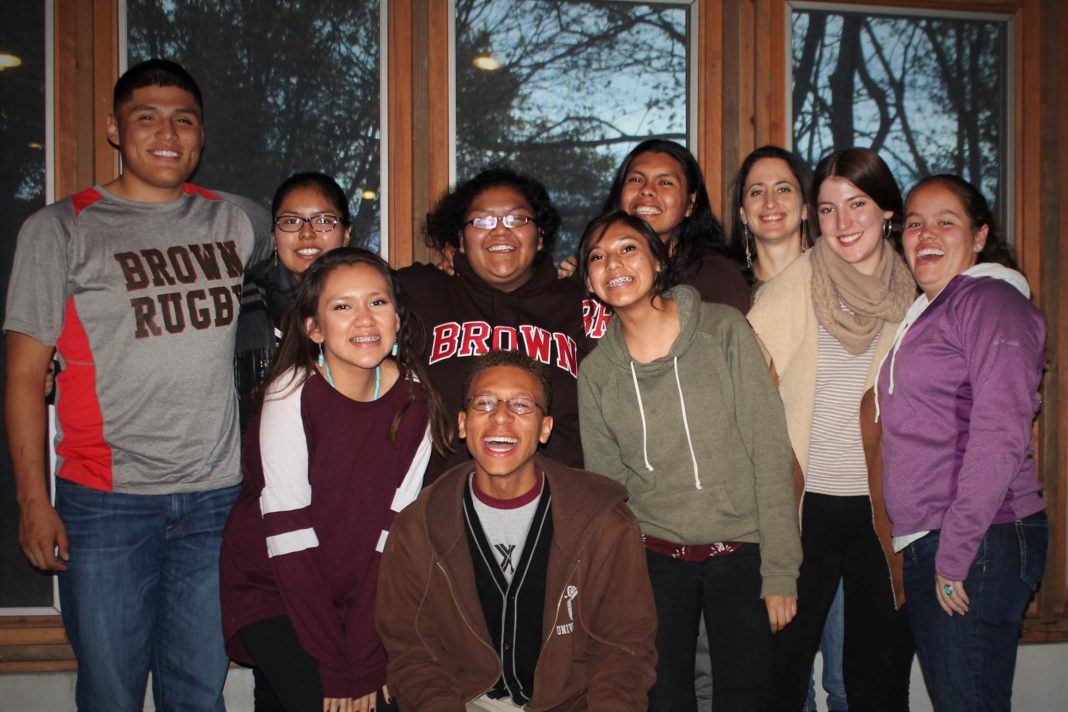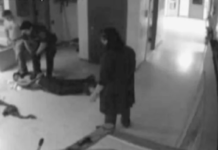NATIVE AMERICANS AND THE IVY LEAGUE
Dartmouth College was founded to educate Native Americans. The College on the Hill continues that tradition today by being a leader in educating Native Americans. As an example, they’ve got a great Native American studies department at the university (photo credit: Gavin Huang).
Native American students in the Ivy League are in short supply, with exception to Dartmouth College. According to a piece in “Indian Country” by Tanya H. Lee entitled “American Indians Go Ivy League,” the percentage of American Indian and Alaska Native undergrads within the Ivy League colleges rests at around 0.5%. That’s right. 0.5%. One exception among the eight Ivy League colleges is Dartmouth. With 175 American Indian and/or Alaska Native undergraduates at The College on the Hill, the university boasts a much higher statistic — 4% of the student body. Princeton on the other hand? Not so much!
Dartmouth was founded as a college for the education of Native Americans. It’s a part of the school’s rich tradition and it’s part of the reason the school excels in attracting the best and brightest Native American students from across the United States. According to the piece in “Indian Country,” “Dartmouth is serious about recruiting and retaining American Indian students. Its efforts, says Paul Sunde, director of admissions, involves visiting schools and tribal communities and participating in the National Indian Education Association’s conference and the College Horizons programs. Then there is Dartmouth’s unique Native American Fly-In program, which brings 50 students interested in the Native community and/or Native American Studies to campus to find out what Dartmouth offers, meet professors, administrators and other students and learn about the application process and financial aid. Dartmouth pays airfare and provides room and board for participants.”
So why, we ask, can’t the other seven Ivy League institutions make these kinds of efforts like Dartmouth? These measures seem quite logical! Penn having ten Native American students in its incoming class four years ago just isn’t acceptable, although this number has climbed to 30 this year. It’s progress at least. And we don’t mean to single out Penn because the numbers for Princeton are even worse.
Have a question on Native American enrollment within the Ivy League? Let us know your questions by posting below. We look forward to hearing from you! And, while you’re here, check out our Ivy League Admissions Statistics.

American Indians Go Ivy League
American Indians are underrepresented at most Ivy League schools. The percentage of American Indian and Alaska Native undergraduates at the Ivy Leagues hovers around 0.5 percent, with the notable exceptions of Dartmouth College in New Hampshire, where 175 American Indian undergrads account for four percent of the student body, and on the other end of the spectrum, Princeton University in New Jersey, which has the lowest percentage of AI/AN undergrads.
The U.S. Census Bureau reports that in 2012 American Indians and Alaska Natives comprised 1.2 percent of the population. The question of why this underrepresentation persists could lie in some assumptions about Ivy League schools that deserve scrutiny.
Admissions and Financial Aid
The eight Ivy League schools have the reputation of being academically rigorous and extremely expensive. They are both. Applicants must have excellent grades and high SAT scores. But there are other factors. More than 35,000 people applied to Harvard for the class of 2017. Harvard offered places to only 2,029, or 5.8 percent, which on the same order of magnitude as acceptance rates at other Ivy League schools. So factors such as ethnicity/race, geographic location, recommendations, application essay, interview and non-GPA-related academic and other accomplishments play into admissions decisions.
The price tag for one year at an Ivy League school runs about $59,000. However, the majority of undergraduates do not pay that amount, and some pay nothing at all.

Courtesy Cornell AIP
Proud students with AIP and Cornell flags.
All of the Ivy League schools have needs-blind admissions—that is, they do not consider financial need when making admissions decisions. All of the schools also guarantee that if an applicant is admitted they will put together a financial aid package that will allow the student to attend—they will meet 100 percent of demonstrated need.
Financial aid packages often include grants, loans, work-study, private scholarships and a family contribution. However, some Ivy League schools—including Princeton, Harvard, Yale and University of Pennsylvania, and in some circumstances Dartmouth and Cornell—offer financial aid packages that include no loans, so students graduate debt-free.
At some schools, students whose families earn under a specified amount ($100,000 at Dartmouth, $65,000 at Harvard and Yale, for example) make no financial contribution to their education. The average cost for students on financial aid at Harvard is $12,000 a year, about the same as or less than it would cost to attend many state universities.
American Indian Studies and Support at Ivy League Colleges
Dartmouth is serious about recruiting and retaining American Indian students. Its efforts, says Paul Sunde, director of admissions, involves visiting schools and tribal communities and participating in the National Indian Education Association’s conference and the College Horizons programs. Then there is Dartmouth’s unique Native American Fly-In program, which brings 50 students interested in the Native community and/or Native American Studies to campus to find out what Dartmouth offers, meet professors, administrators and other students and learn about the application process and financial aid. Dartmouth pays airfare and provides room and board for participants.
Started in 1972, two years after Dartmouth recommitted to its founding purpose, “the education and instruction of Youth of the Indian Tribes in the Land in reading, writing & all parts of Learning which shall appear necessary and expedient,” its interdisciplinary Native American Studies program offers a major and a minor course of study, says NAS Chairman N. Bruce Duthu, United Houma Nation of Louisiana. NAS has eight faculty and 25 courses on offer at any one time. Dartmouth also funds internships for students who want to do research in Native communities for a 10-week stretch and offers a predoctoral fellowship to bring a grad student to the college to write his or her thesis. The Gordon W. Russell Visiting Professorship in Native American Studies brings an American Indian senior scholar to teach for a semester. A Native American residence offers students the option of living with other AI/AN students. “We offer a strong support network,” says Sunde, “with the goal of helping students not just to stay in school and do well but to excel beyond their own and others’ expectations.”

Joe Mehling
Janine Bowechop, executive director of the Makah Cultural & Research Center, at Dartmouth.
AI/AN enrollment at Princeton University in New Jersey has consistently fallen over the past six years from 34 students in 2007–2008 to nine now, under 0.2 percent of the undergraduate student body. The university’s explanation is that enrollment varies from year to year. Princeton’s American Indian Studies Working Group is intended to be “a hub for students and faculty interested in the multidisciplinary field of Native American and Indigenous Studies.”
Cornell’s land grant mission—to return benefits to the citizens of the state—early on led to a number of relationships with the Haudenosaunee Nation, including agricultural programs that have been in place for well over 50 years, says American Indian Program (AIP) Director Jolene Rickard, Tuscacora. AIP is a cross-college, interdisciplinary program that offers a combination of American Indian Studies courses and other educational, social and cultural opportunities. The program’s rigorous course of study can earn students a minor in American Indian Studies. The program is expanding its area of interest to include indigeneity within an international context.
Rickard strongly recommends that AI/AN students considering Cornell, located in Ithaca, New York, get in touch with AIP, which can help arrange preapplication visits, meetings with faculty and students and housing in the university’s Akwe:kon residence hall for Native students. “We’ve often been very helpful in getting successful admissions for students who work with us. We encourage students and parents and families to reach out to our student support staff. When we know a Native student is applying to Cornell, we carefully watch that application.”
Jason Packineau, an enrolled member of the Three Affiliated Tribes and community coordinator for the very active Harvard University Native American Program, says the university conducts outreach at schools and conferences and participates in College Horizons. The university has a Native American admissions officer who does outreach and helps evaluate applications. Packineau says 2.7 percent of the Class of 2017 is Native American or Native Hawaiian.
Harvard College, chartered in 1650 for “the education of the English & Indian Youth of this Country in knowledge and godliness,” has a number of programs focused on the American Indian community, including a summer museum internship at the Peabody Museum, the Four Directions Summer Research Program for Native Americans, the Native American Youth Enrichment Program for Boston-area youngsters and, through the Kennedy of Government, the Harvard Project on American Indian Economic Development, which includes the Honoring Nations program, an awards program that honors outstanding examples of tribal governance. The field research course, Nation Building, responds to research requests from tribal communities, and HUNAP’s Native Health Program, the Native American Statistics Program, and the Harvard Indigenous Law Clinical Program offer other opportunities. Native Americans at Harvard College, a social club, was founded in 1972.
Located in New York City, Columbia University has just launched the Native American/Indigenous Studies Project under the umbrella of its Center for the Study of Ethnicity and Race. The project’s goals are “to increase capacity building for Native American/Indigenous Studies at Columbia in the areas of teaching, research, and public programming. Current projects in development include: a speaker series featuring scholars, political figures, and artists; a guest speaker series on topics for Native American courses; and the creation of a research and teaching fund for Native Americanist/Indigenous Studies faculty.” Columbia has an interdisciplinary major in Ethnicity and Race Studies, which includes some courses on Native American history and issues. At Columbia, Native American students comprise almost twice the average percentage of the student body. Three percent of the Class of 2017 is Native American.
The University of Pennsylvania has increased American Indian enrollment in its entering class from 10 students four years ago to 30 this year, says Tina Fragoso, Nanticoke Lenni-Lenape, coordinator of Native Recruitment and assistant director for equity and excellence. The school is in the process of developing a Native Studies Program with input from students and works closely with the Choctaw Nation on a scholarship advisement program. Funding for student research comes from the Greenfield Intercultural Center, while a Native residence is a housing option for American Indian students and others interested in Native studies.

Courtesy UPenn
Lenape Turtle Garden at the University of Pennsylvania.
One of Penn’s greatest strengths, says Fragoso, is its Association of Native Alumni, which brings graduates back to mentor current undergrads and provide support. “We want to foster a sense of belonging here for American Indian students,” says Fragoso, noting that her office continues its involvement with students throughout their undergraduate career. The student organization, Natives at Penn, brings in speakers from different tribes and hosts a spring powwow.
Brown University in Providence, Rhode Island offers an undergraduate Ethnic Studies concentration in its American Studies Department. The concentration allows students to focus in Native American, Asian American, or Latino Studies. A spokeswoman for Brown cited a number of support programs for minority students, including the Third World Transition Program, Minority Peer Counselor Program and ALANA Mentoring Program. Brown’s “Native American Heritage Series, in collaboration with the student support organization Native Americans at Brown, focuses on the politics and culture of Native Americans. Events have included the Native American Frybread Social and the annual Spring Thaw Pow Wow.”
Yale University in Connecticut has recruitment events scheduled across the country this fall, including in Phoenix, Tucson, Oklahoma City and the Los Angeles area. The Native American Cultural Center, in partnership with the Association of Native Americans at Yale, “promotes Native American culture and explores the issues that Native Americans face in today’s world.” About three quarters of one percent of Yale’s undergraduate student body is Native American. The Association of Native Americans at Yale is a student-run cultural organization.
Most Ivy League colleges will waive the application fee on an individual basis, depending on a student’s financial situation. Go Ivy!
College Horizons
College Horizons is a weeklong summer program for Native American, Alaska Native and Native Hawaiian 10th-grade and 11th-grade students who gather information about various colleges and universities. The organization’s goal is to let students know that college is accessible and to help them with their applications. The first of two 2014 College Horizons workshops will be held at Dartmouth. Applications became available October 1; they are due by February 4.

Joe Mehling
Hilary Tompkins, a solicitor at Interior, speaking at Dartmouth
College Board Info Packets
In response to research that shows low-income students with good grades and high SAT or PSAT scores often do not even apply to Ivy League schools, the College Board has begun sending out packets of information and application-fee waivers for six colleges of the student’s choice, to seniors scoring in the top 15 percent on the SAT or PSAT from families in the bottom quarter of income distribution.
No More SATs?
The National Association for College Admission Counseling has called on colleges to consider dropping the requirement that applicants take the SAT or ACT test, in part because they discriminate against students who cannot afford coaching.
Bard College in Annandale-on-Hudson, New York is one college that has done that. Beginning this fall, Bard is offering applicants the option of writing four 2,500-word research papers in lieu of taking the SATs. A cumulative score of B+ or better means automatic acceptance. Bard has needs-blind admissions and has a substantial financial aid program, but it does not commit to meeting 100 percent of demonstrated need for everyone. 











